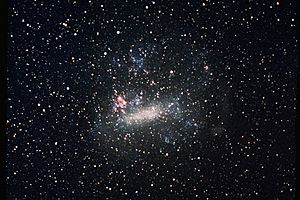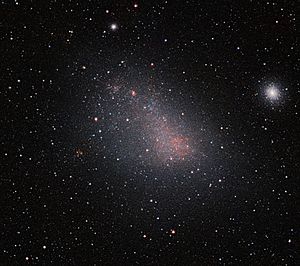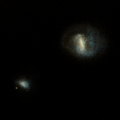Magellanic Clouds facts for kids
The Magellanic Clouds are two small, oddly shaped galaxies. They don't have a regular spiral or oval shape like many other galaxies. These galaxies have billions of stars, but they are much smaller than our own Milky Way galaxy. You can only see the Magellanic Clouds from the southern part of Earth. They actually orbit around our Milky Way galaxy.
The Magellanic Clouds, along with the Milky Way and the Andromeda Galaxy, are part of a bigger group of over 50 galaxies called the Local Group. The two clouds are known as:
- Large Magellanic Cloud (LMC)
- Small Magellanic Cloud (SMC)
Contents
History of the Magellanic Clouds
The first time the Magellanic Clouds were written about was by a Persian astronomer named Al Sufi. This was in the year 964. He wrote a book called Book of Fixed Stars. In his book, he called the Large Magellanic Cloud al-Bakr, which means "the Sheep" of the southern Arabs. He noted that you couldn't see this cloud from northern Arabia or Baghdad. But you could see it from the strait of Bab el Mandeb, which is the southernmost point of Arabia.
Europeans first saw these clouds much later, at the end of the 1400s. Italian explorers Peter Martyr d'Anghiera and Andrea Corsali were among them. Later, Antonio Pigafetta also saw them. He was with Ferdinand Magellan on his trip around the world from 1519 to 1522. Even though Magellan's trip helped make them famous, people didn't start calling them the Magellanic Clouds until much later.
In 1661, a book by Bayer called Uranometria named them nubecula major and nubecula minor. These names mean "larger cloud" and "smaller cloud" in Latin. Then, in 1756, a French astronomer named Lacaille made a star map. He called them le Grand Nuage and le Petit Nuage, which means "the Large Cloud" and "the Small Cloud" in French.
Characteristics of the Magellanic Clouds
You can easily see the Magellanic Clouds without needing a telescope. They look like separate, hazy patches in the night sky, away from the main band of the Milky Way. In the sky, they appear about 21 degrees apart. But in real space, the distance between them is about 75,000 light-years. For a long time, scientists thought they were the closest galaxies to our Milky Way. However, in 2003, the Canis Major Galaxy was found. It is now thought to be our closest galaxy.
The Large Magellanic Cloud (LMC) is about 160,000 light-years away from us. The Small Magellanic Cloud (SMC) is a bit farther, at about 200,000 light-years away. The LMC is about 14,000 light-years wide. The SMC is smaller, about 7,000 light-years wide. To compare, our Milky Way galaxy is much larger, about 170,000 to 200,000 light-years across.
Scientists believe that the shapes of the Magellanic Clouds have changed. This is because of the strong pull of gravity from the Milky Way. As they travel close to our galaxy, its gravity pulls on them. Streams of neutral hydrogen gas connect the Clouds to the Milky Way and to each other. Both Clouds actually look like they might have been spiral-shaped galaxies a long time ago. Their gravity has also affected the Milky Way. It has pulled on the outer parts of our galaxy's disc shape.
The Magellanic Clouds are different from our Milky Way in a few ways. They have a different structure and less mass. They are also "gas-rich," meaning they have more hydrogen and helium gas compared to the Milky Way. Another difference is that they are "metal-poor." This means they have fewer heavy elements than the Milky Way. The youngest stars in the LMC and SMC have less than half the amount of other elements. Both Clouds are known for their many nebulae (clouds of gas and dust) and a large number of young stars. Like our own galaxy, their stars range from very young to very old. This shows that the Clouds have been around for a very long time.
A very bright supernova (a huge star explosion) called SN 1987A happened in the Large Magellanic Cloud. When it exploded, it was the brightest object seen from Earth in over 400 years!
In 2010, a French scientist suggested that the clouds might have been thrown out from a collision that formed the Andromeda Galaxy six billion years ago. However, most astronomers think the Magellanic Clouds formed in the same way our Milky Way Galaxy did.
Mini Magellanic Cloud
New research suggests that the Small Magellanic Cloud (SMC) might actually be split into two parts. A smaller part might be hidden about 30,000 light-years behind the main SMC. This could have happened if the Large Magellanic Cloud (LMC) pulled on the SMC, causing it to split. The two sections might still be moving apart from each other. This smaller, hidden section is being called the Mini Magellanic Cloud.
Images for kids
-
LMC and SMC rendered from Gaia EDR3 data with foreground stars removed
See also
 In Spanish: Nubes de Magallanes para niños
In Spanish: Nubes de Magallanes para niños






